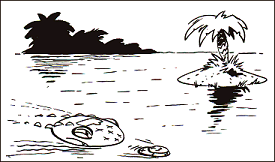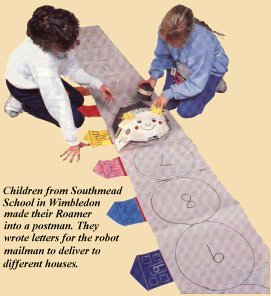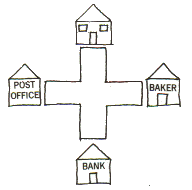
|
Feedback Form

YOUNG ROAMER 2

In the last issue of "GO" Margaret Harris and Margaret Williams, advisory teachers in Devon, described activities to increase young children's understanding of the language needed to program the Roamer, (Forward, Turn, etc). Their second article, adapted from their booklet on Big Trak, 'Making Tracks', looks at early activities with the Roamer which develop this understanding with hands-on experience.
For most of these activities it is necessary to clear memory at the end of each 'turn'.
| Clearing the Roamer's GO memory To clear the Roamer's memory press CM CM. The first time CM is pressed a warning is sounded. If it has been pressed by mistake, press another key or wait 10 seconds and the first press will be ignored. The Roamer will then carry on with its memory intact. |

| Crocodile Island:
Mark out the banks of a river on the floor and place an island in
the middle. Make the Roamer into a crocodile and place it by the river
bank facing the island. Mark its starting position. Ask the children
if they can work out which keys to press to get the crocodile onto
the island. Once a child has discovered how to get the crocodile to the island, ask pupil if they can make it return to the river bank. The first solution may be to turn the Crocodile around and use the same instructions. Encourage the children to find a key that will bring the crocodile back without turning it around, "Do you think the crocodile can swim backwards?" |

Number Track: This activity is useful for children who do not
understand the relationships between numbers on a number line.
Make a number track with steps of 30cm, one Roamer length. Tell the children
to place the Roamer on 0 and move it to a number. Ask them what they discovered.
Then ask them to move it back to 0.
When the children have mastered starting on 0, the Roamer may be started
from another number. For example, "The Roamer is on 3. How many steps
will you program for the Roamer to move to 7?"
The track may be used later for counting back activities.
Number Track Game: The number track activities may be developed
into a game.
Make a set of cards numbered 1 to 5, with a forward or back symbol. There
should be more cards with the forward symbol than with the back symbol.
Shuffle the cards and place them face down on the floor.
The first player places the Roamer on 0, draws a card and keys in the
instruction. If you have only one Roamer, the first player places a marker
where the Roamer stops, and returns it to the starting line, where the
second player takes a turn. If you have two Roamers the second player
plays with the second Roamer, so it is not necessary to use markers.
The first player to reach square 11 is the winner. The teacher can ask
questions like, "You are on 3 and your card says go forward 2. What number
will the Roamer stop on?"
Measuring Distances: A Roamer length is a useful arbitrary unit
for measuring distances in the classroom.
Ask the children to guess how many Roamer lengths are between two pieces
of furniture, then check their estimate with the Roamer. Sometimes the
Roamer will not measure the distance exactly. Phrases such as "and a little
bit," or "not quite" are perfectly acceptable.

Crossroads: Mark out crossroads on the floor with a destination
(shop, garage, house, etc.) at the end of each road. Ask the children
to move the Roamer from one point on the crossroads to another.
There is also a range of introductory moving and turning activities in
the Valiant booklet, Geometry Microworld Part I. The first issue of "GO"
contains an article on the Roamer's unit setting feature which tells you
how to change the units of turn to make them more suitable for younger
children.
| Back |
|---|